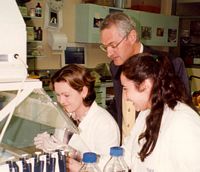


The development of microvascular surgery in Australia
Introduction
Participants
Beginnings
Developing links with academia and hospital medicine
A bevy of supporters
An ever-widening circle of contributors
Building research capacity
Nurturing relationships
Raising funds for research and development
The microsurgeon and the law
Winning community and corporate support
Leadership
The Institute and its style
Endnotes
Index
Search
Help
Contact us

Geoff Renton: We've obtained a small grant from them for hand surgery. Things have changed a lot with our move into tissue engineering. We are now doing a lot of work on breast and prostate cancer. An English company and hospital wanted to do work on prostate cancer cells and because they cannot use calf serum to do the work and Australia is free of Creutzfeld Jacob Disease, we have a contract to do that work here. That fits in with our work on cell metastasis, and that cell work fits in with the tissue engineering we’re doing.

Geoff Renton keeps in touch with the Institute’s activities and personnel. Used with the permission of the Bernard O’Brien Institute of Microsurgery.
So this metamorphosis has gone on and the place is expanding in terms of numbers of staff. As I said before, we wanted to continue to be an Institute where we published and gave our work to the world. But we've had to patent everything to pay our way because a lot of funding sources have dried up. In a way it may be good, but it was better before in the sense that we had funds for education. We trained a lot of people, such as honours students from many different disciplines – pharmacology, pathology, physiotherapy – who came for a year. There were also four to seven PhD students, who didn’t stay here but went on to scientific careers elsewhere.
In addition, we have trained many young surgeons and that's been a benefit to the people of Melbourne and Victoria. You may remember the lass at Shepparton who had her face torn off and she was brought to St Vincent’s. Yoshio Tanaka[88] and Wayne worked in two tag teams. Yoshio was part of the tissue engineering group at the time and the two teams worked for about 32 hours, one lot on one table was sorting out the scalp and the face, and the other was working with the patient to find the blood supply. They did a marvelous job. It’s occasions like that - with all those people together and the science that was going on at the time - that have a practical application straight into the clinical area.
I understand that this Institute created a technique in surgery that used to require 14 days hospitalisation and that now takes 7 days. I often think it's a pity that the Institute didn’t get paid for a day of hospitalisation saved and then we’d have good funding for research. The ethos here is that the Institute’s scientific and medical staff really just want to get on with the research and with what they do best, they’re not interested in the finance and the business side of it. And that’s where we need the Board, the expertise of its members, and the outside help.
 |
Witness to the History of Australian Medicine |  |
© The University of Melbourne 2005-16
Published by eScholarship Research Centre, using the Web Academic Resource Publisher
http://witness.esrc.unimelb.edu.au/066.html